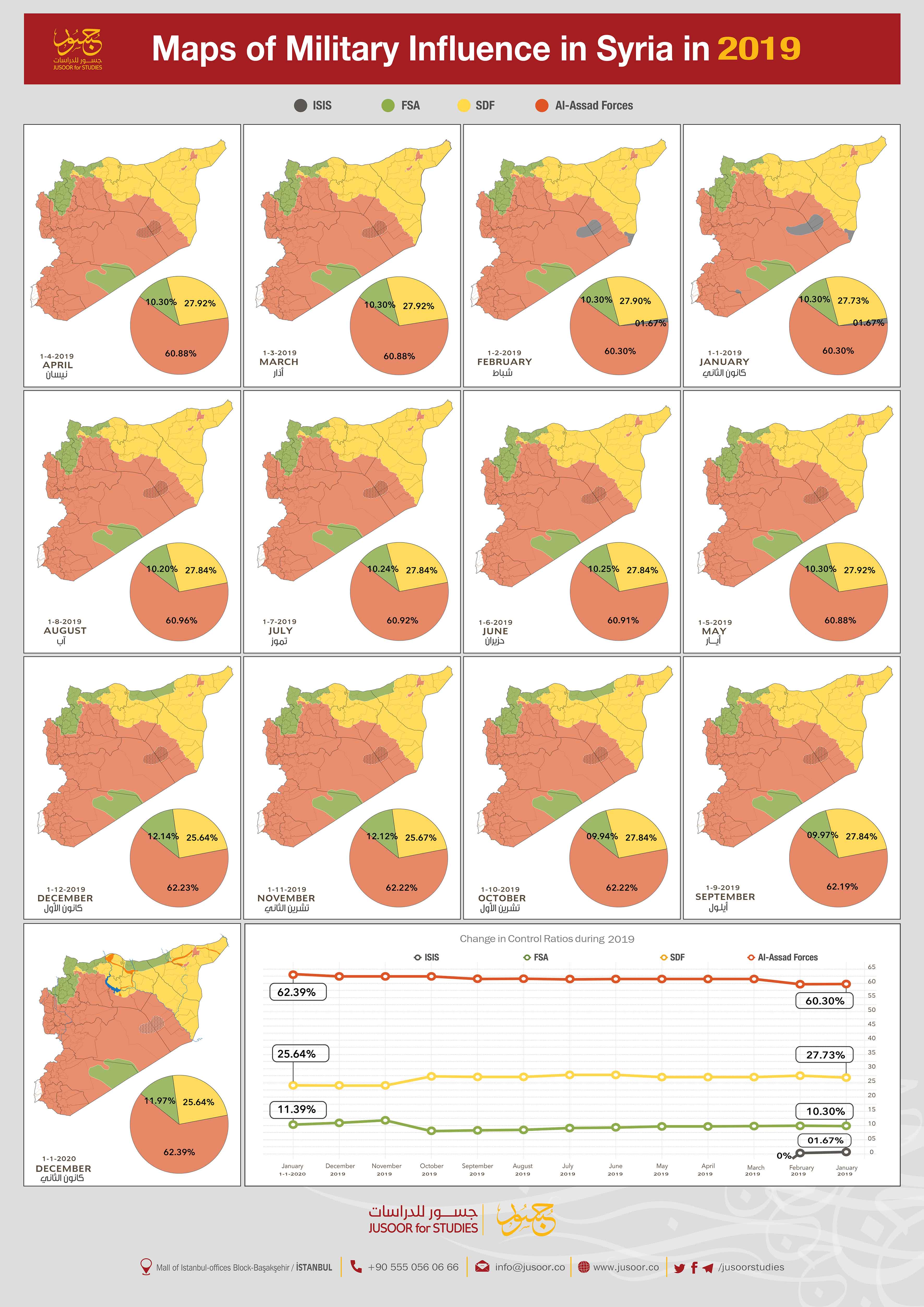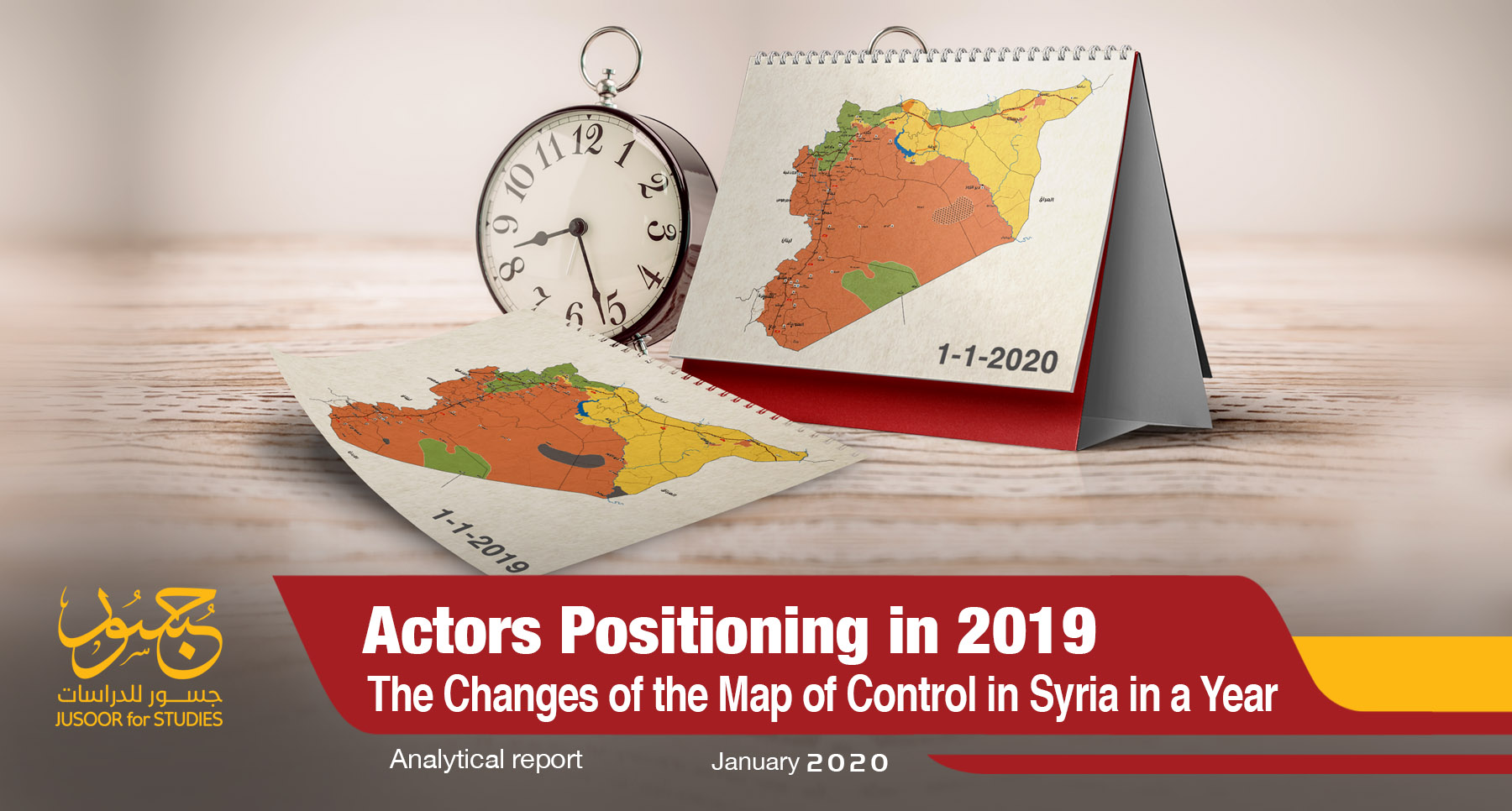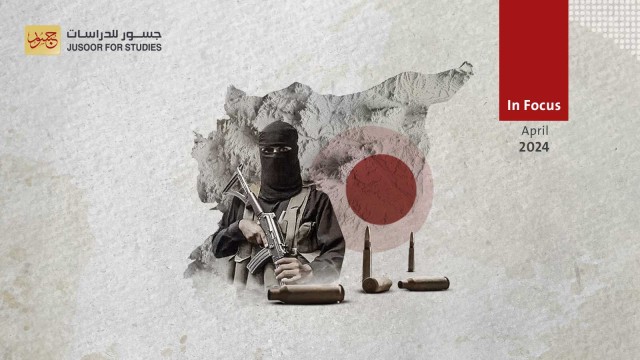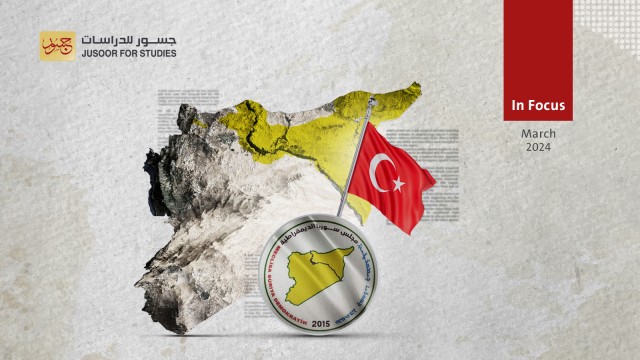Introduction
With the start of 2019, the Syrian opposition was due for internal fighting between the National Front for Liberation and Hayat Tahrir al-Sham (HTS) with HTS making every effort to expand its control over key areas of control. The internal struggle weakened the opposition’s military resilience at a time when it was anticipating a possible campaign to take its last strongholds in the north of the country.
With the start of the Syrian regime ground campaign backed up by Russia and later Iran, the opposition factions were able to slow down the attack and increase its military cost. However, they were unable to stop it completely especially with HTS’s lack of desire to participate effectively. HTS did not see any usefulness in being heavily involved in the fighting in light of other future entitlement that it might face to survive and maintain its gains.
The Syrian opposition is now facing a major challenge when dealing with the future of HTS since it can neither fight it nor can depend it on HTS for effective military cooperation to achieve a change in the field regarding the map of control and influence. Overtime, the Syrian opposition factions have become convinced that it is futile to rely on the Turkish observation points to curtail any military attack or campaign that the Syrian regime or its allies may launch. All of these factors perhaps contributed to the Syrian opposition pushing to unifying its gains and military achievements in the areas of Turkish military presence. This can be seen in the National Front for Liberation’s move to join the Syrian National Army.
In the case of the regime, 2019 presented opportunity to continue expanding its control in the field in the north considering the inability of the Sochi Agreement (2018) to subject the buffer zone to the regime’s control or influence. The situation was not different east of the Euphrates where the regime took advantage of the Syrian Democratic Forces (SDF) situation following the United States of America (USA) announcing withdrawal of its forces from northeastern Syria along the border.
In 2019, the SDF faced the biggest challenge since the foundation of the Self-Administration by the Kurdish Democratic Union Party (PYD) in 2014.
Likewise, ISIS faced further decline in military activity and organizational leadership.
This report will examine the changes in the control ratios of the actors on the ground and the impact of these changes on the military and political positioning in 2020.
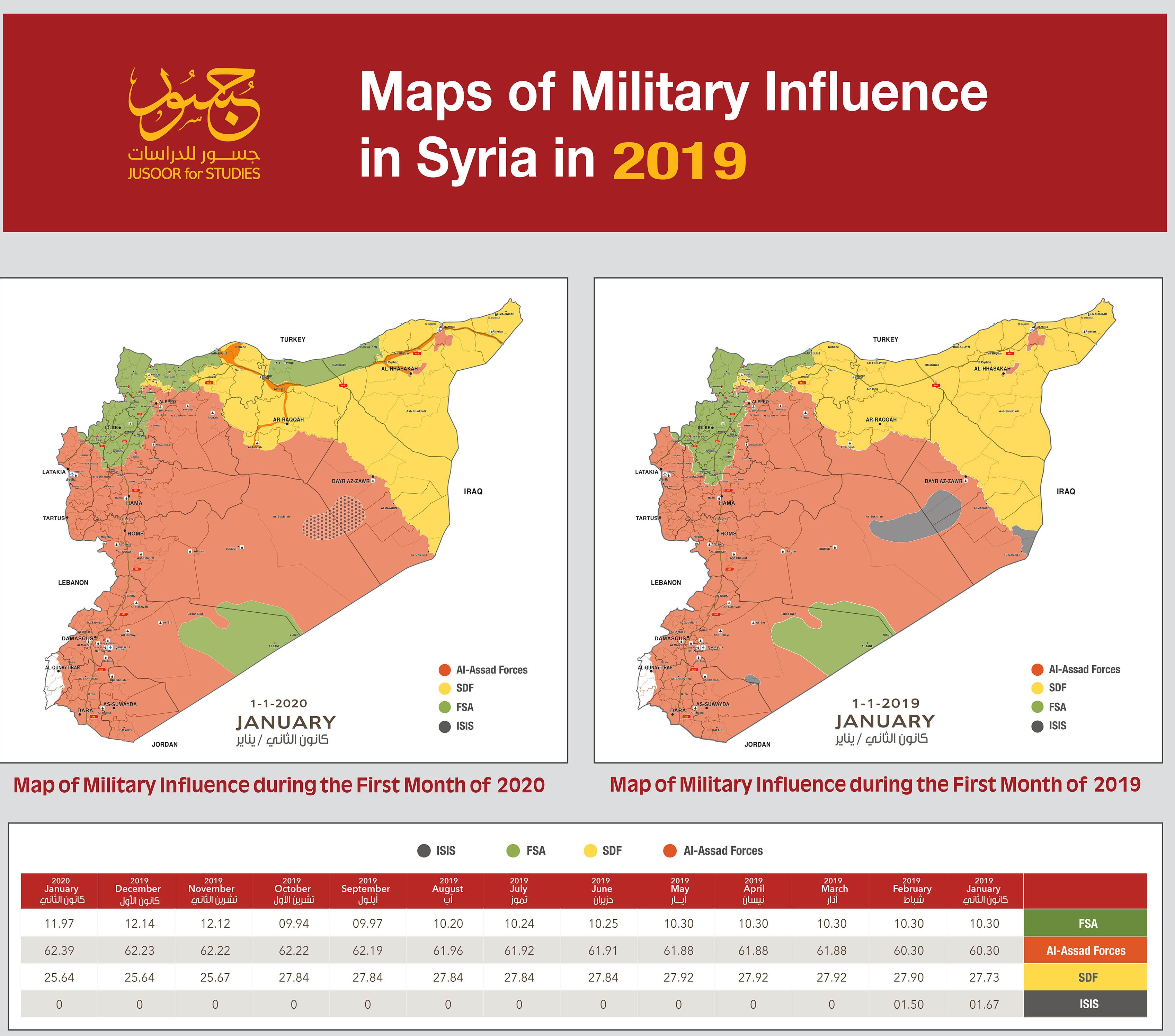
First: Change at the Level of Actors
The year 2019 carried major changes for the various actors in the map of control and influence. On the one hand, like 2018, the Syrian regime benefited the most whereas the biggest loser was ISIS. On the other hand, there is a discrepancy in the degree of gain and loss for the Syrian opposition, and the SDF has lost the most compared with the remaining actors.
1) Regime Forces
In 2019, the Syrian regime and its allies, Russia and Iran, continued to enhance the military achievements they gained in 2017 and 2018. The regime expanded its field of influence and its control ratio against the remaining local actors whose ratio stabilized at (62.39%) to the ratio recorded last year with (60.3%).
The main factors which facilitated the regime increasing its influence was the third military campaign launched between 2 February and 30 August 2019, and the fourth military campaign launched on November 14, 2019 on the de-escalation zone in Idlib Province with ground and aerial support from Russia.
Here are the most prominent field achievements the regime gained throughout 2019:
• In February 2019, the regime took advantage the military defeat of ISIS to include the Palmyra Desert, an area of (1.5%) of the total area of Syria, to its spheres of influence.
• The regime forces launched a surprise attack on SDF locations in Raqqa’s southern countryside and took control of Hwrat al-Jaryat, but the International Coalition quickly intervened to stop the attack.
• In May 2019, the regime forces started a large-scale ground operation on the southern section of the de-escalation zone following intense fighting that lasted nearly 3 months, taking control of an estimated 77 km2.
• In June 2019, the regime forces expanded its scope of influence in the southern section of the de-escalation zone to control an area of 101 km2. In addition, in June the regime forces repeatedly bombed the Turkish observation points in Hama countryside.
• In July 2019, the regime forces recaptured strategic locations from the Syrian opposition in the southern section of the de-escalation zone and expanded its field control by gaining an area of 106 km2 since the start of the ground invasion.
• In August 2019, the regime forces gained control of all of the southern section of the de-escalation zone which includes the cities of Khan Sheykhoun, Kafar Zita, al-Latamneh, Morek and other areas including strategic villages, farms and hills. As a result, the regime encircled the Turkish observation points in Morek north of Hama and later, Russia announced a unilateral truce on August 31, 2019. Since the ground invasion the regime controls around 580 km2 of Syrian territory.
• In September 2019, the regime forces enhanced its control on the southern sector in the de-escalation zone by capturing some locations in the vicinity of Khan Sheykhoun without adhering to the unilaterally announced Russian truce declared in August 2019. The gains did not affect the total area under regime control recorded in August.
• In October 2019, the regime forces entered the safe zone and Manbij, east of the Euphrates, and established military points there according to a memorandum of understanding with SDF signed in mid-October; however, this deployment did not affect the regime’s total ratio control ratio over territory in Syria.
• In November 2019, the regime forces resumed fighting in the de-escalation zone following the unilateral truce announced by Russia at the end of April 2019 and gained control of three villages in the southeastern countryside of Idlib.
• In December 2019, within the framework of the fourth military campaign on the de-escalation zone, regime forces gained control of several strategic hills, villages and towns most prominently, Jarjanaz, southeast of Idlib. Thereby, the regime was very close to the strategic city of Maaret al-Numan and it encircled the Turkish observation points in Tal al-Surman.
2) Opposition Armed Factions
The opposition factions’ area of control expanded in 2019, reaching (12.13%) at the end of December, compared to the estimate ratio of (10.3%) recorded in 2018.
Although the Syrian opposition factions lost large areas from the de-escalation zone in Idlib province and its vicinity during 2019, the Turkish Army and the Syrian National Army’s military operations in the last third of 2019 contributed to improving its position and increasing its control at the expense of other actors in the field.
The following are the most prominent armed opposition factions’ field gains as well as the military transformations achieved throughout the year:
• In January 2019, HTS established firm control on the sources of power and wealth in the de-escalation zone by launching a large-scaled military attack against several rival factions including: Nur al-Din al-Zanki Movement west of Aleppo, Ahrar al-Sham west of Hama and Suqour al-Sham south of Idlib. These are factions are part of the National Front for Liberation.
• In May 2018, the opposition factions declared a battle to recapture areas lost to regime forces in the northwestern countryside of Hama. The factions were able to establish their positions in some locations, but quickly withdrew due to heavy Russian aerial bombardment.
• In June 2019, the opposition factions were able to alter the scope of military control in the northwestern countryside of Hama after the factions captured some advanced and strategic locations along the main supply road between Suqalabiyah and Muhardah. These locations are outside the de-escalation zone. However, the factions were only able to control these areas for around six weeks.
• In October 2019, the opposition factions controlled an estimated 4076 km2 east of the Euphrates within the Fountain of Peace Operation announced by Turkey and carried out between October 9-23 following Turkey and Russia signing the Sochi Memorandum (2019).
• In November 2019, the Syrian opposition factions controlled some locations around Tal Tamir, north of Al-Hasakah, and Ayn Issa, north of Raqqa, thereby achieving a slight increase in the total area of control and influence. It must be noted that the fighting continued despite the announcement of the end of the Fountain of Peace Operation.
3) Syrian Democratic Forces
In 2019, SDF lost the gains it made in the field during its war on ISIS in 2018 as it lost the cities of Tal Abyad and Ras al-Ayn north of Al-Hasakah in addition to several villages and towns to the Syrian opposition factions. SDF controlled area and its control ratio was reduced and stabilized at (25.64%) compared to the ratio (12.13%) recorded in 2018.
The following are the most prominent SDF gains in the field as well as the military transformations throughout the year:
• In January 2019, SDF completed its last stage of the Al-Jazeera Storm Battle operations it launched in May 2018. SDF controlled al-Shaghfa and al-Susa towns within Hajin pocket, the last ISIS pocket east of the Euphrates, thus, ISIS was isolated in the villages of al-Marashdeh, BuBadran and al-Baghoz.
• In February 2019, SDF announced its control of the entire Hajin pocket, the last ISIS held area east of the Euphrates. ISIS fighters were besieged in an area that did not exceed half a km2 (500,000 m2). The majority of ISIS fighters surrendered themselves to SDF, following an agreement of unknown nature, while those who refused to surrender were bombed.
• In October 2019, SDF rushed to sign a memorandum with the Syrian regime, under the auspices of Russia. The memorandum states that the regime will deploy its forces east of the Euphrates at a depth of 32 km along the border, without entering the main cities except with the approval and accompaniment of the Kurdish administration. This agreement was reached to obstruct the Turkish launched Fountain of Peace Operation started in October 2019.
4) ISIS
In 2019, ISIS lost all the areas under its military control in Syria, following a series of defeats in 2017 and 2018. Therefore, ISIS no longer controls any Syrian territory.
At the outset of 2019, the major military defeats it faced, pushed ISIS to strengthen its security activities. These activities increased after the SDF and the International Coalition were able to eliminate ISIS control in the field and end the caliphate that ISIS announced in mid-2014.
At the end of October 2019, the USA managed to assassinate the ISIS leader Abu Bakr al-Baghdadi in the “Kayla Mueller” operation carried out in Barisha town, north of Idlib. The operation resulted in the death of al-Baghdadi, several of his aids and a prominent al-Qaeda security leader. In the days following al-Baghdadi’s death, ISIS appointed a new successor, Ibrahim al-Hashimi al-Qurashi.
Change in Control Rations between Actors Over the Year
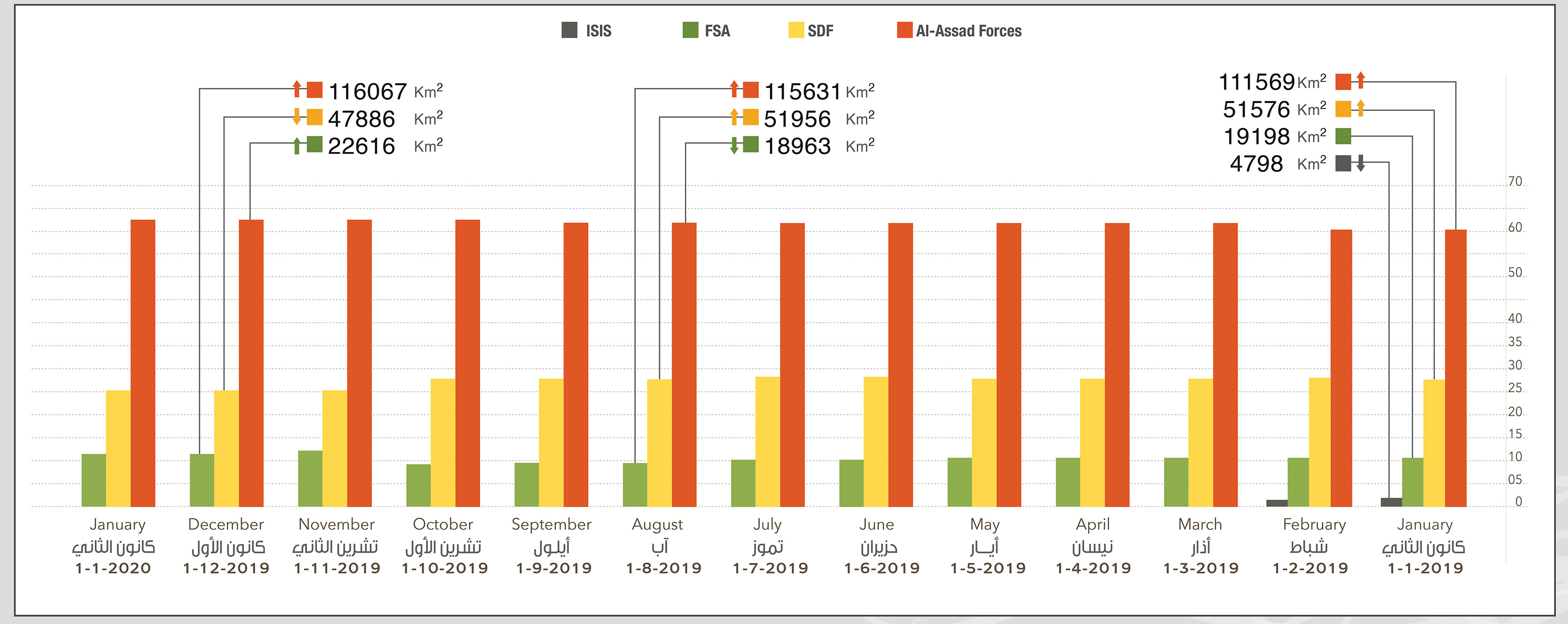
Second: Indications of Transformation in the Map of Control
The major changes in the map of control and influence affected local actors, albeit primarily due to issues concerning foreign funding and intervention. Therefore, the gains that have been achieved are considered power cards for the funding countries and are reflected in the ramifications on local actors.
1) The Syrian Regime
The Syrian regime, and what it represents for the Russian-Iranian alliance, increased its field expansion to become the biggest winner in 2019. Thus, the regime enhanced the results it achieved in 2018 by taking control of two thirds of the country.
The Syrian regime adhered to its desire to regain control of the whole country and managed to enter the eastern region which it had lost complete control over since early 2013. Moreover, the regime sought to expand control in the de-escalation zone north of Syria.
While the regime was seeking to achieve additional military victories at the expense of other actors, Russia was seeking to turn the achievements in the field, that it has brought about since its intervention in Syria, into political gains. However, Russian efforts in this regard were not fruitful whether at the level of the Constitutional Committee, reconstruction or repatriation of refugees. Consequently, the regime’s expanded control and influence poses a major challenge for Russia rather than a sustainable achievement, as long as it is unable to turn these into a political process that Russia sponsors or a process that Russia accepts to secure its strategic and vital interests in Syria. Without this, the regime’s achieved control in the field and its desire to advance further may turn into a burden for Russia especially in terms of stability, which was highlighted by the reconciliations model during 2019.
2) The Armed Opposition Factions
In 2019, the Syrian opposition, and what it represents of an alliance with Turkey, managed to restore balance to its presence in the map of control and influence.
The opposition’s fighting in the de-escalation zone demonstrated that the opposition has a reasonable defense ability compared to its performance in previous years where it suffered consecutive defeats. This can be seen through Russia and Iran having to enter official, contracted or auxiliary ground forces to fight in battles after the Syrian regime forces failed to achieve effective gains in the field.
Turkey would not have preserved a ceiling of gains suited to its existence and interests with respect to the remaining the actors involved in the Astana process concerning Syria, had it not been for the field resistance shown by opposition factions in the de-escalation zone during the third military campaign, as well as their combat effectiveness in an organized military framework during the Spring of Peace operation.
However, the armed opposition factions’ effective military performance does not counter its complete inability to adopt responsible or relatively independent policies at the military, security, and political levels. The National Army’s structure continues to function without being subject to any military, security or administrative government that would shift it from a faction to an institution. Becoming an institution would entail the Army becomes liable, accountable, and subject to oversight, especially in the event of violations by individuals and groups, and, in turn, prevents the international community from attempting to illegally classify the National Army or one of its formations. In addition to the possibility of removing the political and security cover from the Army in the event of unreasonable changes in relations among international actors.
3) Syrian Democratic Forces
In 2019, the SDF was lost the most to regime and the armed opposition factions. These losses were predicted developments due to political events at the end of 2018.
The SDF failed to translate field victories into political gains that guarantee they achieve their demands or part of them, despite the military cover the USA was providing them under the pretext of fighting ISIS. On the one hand, the SDF was not included as a party in the Constitutional Committee and, on the other hand, Washington abandoned providing protection for the SDF following Turkey declaring the launch of the Spring of Peace operation.
Although the Kurdish protection units, which constitute the mainstay of the SDF, sought to provide them with military and political cover by trying to reach an agreement with Russia and the Syrian regime, but even the agreement entails a loss for the SDF to other actors in the field. The agreement moves the SDF from the circle of control and enhancing its field gains to preservation and solely ensuring its survival. As such, preserving its existence is the highest ceiling it can achieve in the next stage at the least estimate.
4) ISIS
In 2019, ISIS activities aimed at attempting to provide suitable conditions for its continued presence at the security level. The activities sought to cause losses for the remaining actors in the field after ISIS became external to the win-lose equation in 2017 and failed to return to the field of influence by controlling some pockets of territory.
